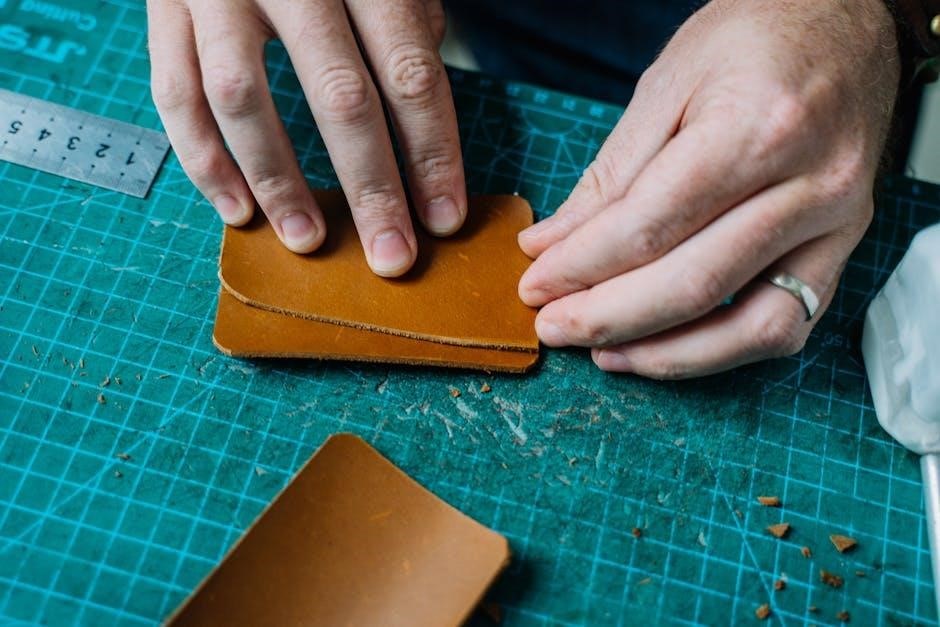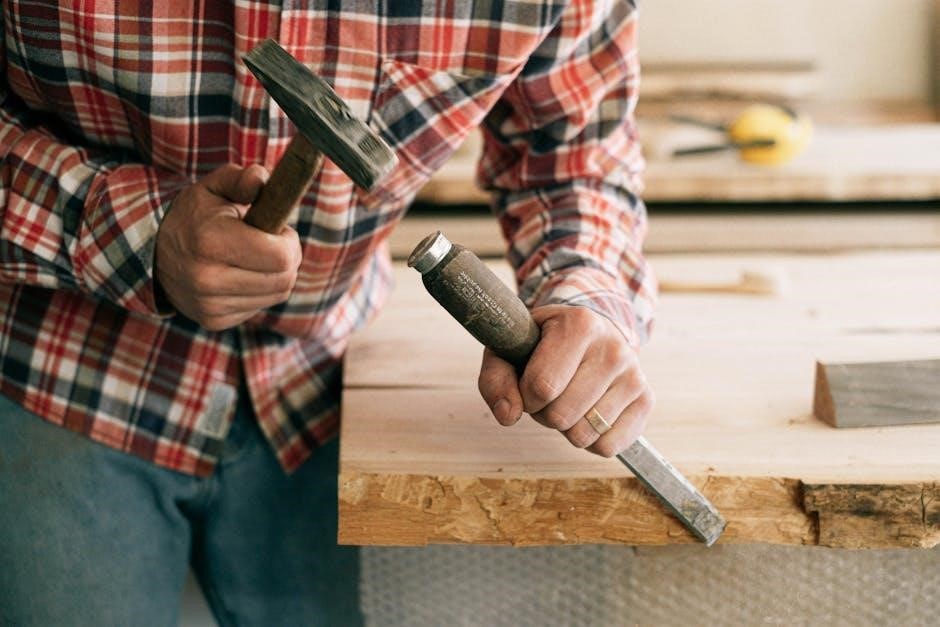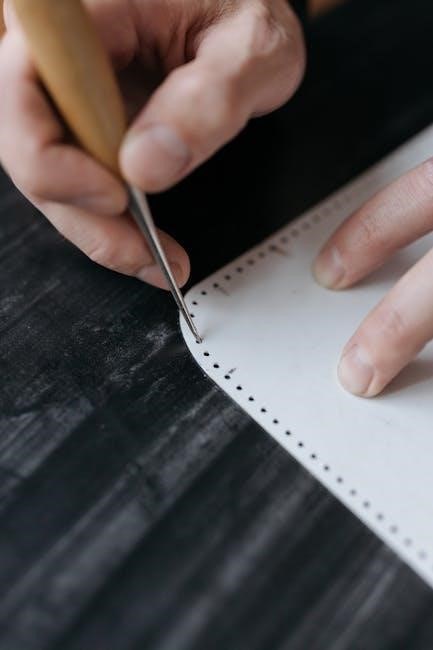A manual sausage maker is a kitchen device designed to stuff and shape ground meat into casings, creating homemade sausages. It offers precise control over ingredients and texture, allowing users to craft personalized sausages with ease and creativity, perfect for culinary enthusiasts and home cooks alike.
1.1 What is a Manual Sausage Maker?
A manual sausage maker is a kitchen tool designed to help users create homemade sausages. It typically consists of a cylindrical hopper, a hand crank, and a sausage casing attachment. The device allows users to fill the hopper with ground meat mixed with seasonings and spices, then turn the crank to push the mixture into casings, forming sausages. This process gives users full control over the ingredients and texture of their sausages, making it ideal for those who enjoy cooking or want to customize their sausages. Manual sausage makers are often preferred for their simplicity, cost-effectiveness, and ability to produce high-quality sausages without relying on electric power.
1.2 Benefits of Using a Manual Sausage Maker
Using a manual sausage maker offers several advantages, making it a valuable tool for home cooks and culinary enthusiasts. It provides cost-effectiveness, as manual models are often more affordable than electric ones. Users also gain full control over ingredients, allowing for customization of flavors and textures. This makes it ideal for those seeking healthier options or dietary preferences like low-sodium or gluten-free sausages. Additionally, manual sausage makers are simple to use and require minimal setup, making them accessible even to beginners. Their durability and lack of complex mechanisms ensure longevity, and they are easy to clean and store. Portability is another benefit, as they don’t require electricity, making them suitable for outdoor or off-grid cooking. Overall, a manual sausage maker is a practical and versatile addition to any kitchen.

How to Use a Manual Sausage Maker
Using a manual sausage maker involves preparing the meat mixture, attaching casings, and manually stuffing them through the device, ensuring consistent and even sausage formation with ease.
2.1 Step-by-Step Guide to Making Sausages
Making sausages with a manual sausage maker is a straightforward process; Begin by grinding and seasoning your meat mixture to your liking. Next, attach the casing to the sausage maker’s nozzle, ensuring it is securely fastened. Feed the meat mixture into the device, turning the handle to push it through. As the mixture fills the casing, guide it gently to form even links. Twist the filled casing to create individual sausages. Once complete, store them in the refrigerator or freeze for later use. Always clean the sausage maker thoroughly after use to maintain hygiene and longevity.
2.2 Tips for Achieving the Perfect Sausage Texture
Achieving the perfect sausage texture begins with the right meat consistency. Use freshly ground meats with a balanced fat content for juiciness. Avoid overworking the mixture to prevent toughness. When stuffing, ensure steady, even pressure to maintain uniformity. Don’t overstuff the casings, as this can lead to bursting during cooking. For a tender texture, use natural casings and avoid twisting links too tightly. Allow the sausages to rest in the refrigerator for 30 minutes before cooking to let the flavors meld and the casings set. Cooking sausages at a medium-low heat prevents splitting and promotes even browning. Experiment with different stuffing speeds and casing sizes to find your preferred texture.
Choosing the Right Manual Sausage Maker
Selecting the best manual sausage maker involves considering durability, ease of use, and sausage size. Durable materials and adjustable settings ensure versatility for various sausage-making needs.
3.1 Key Features to Look For

When selecting a manual sausage maker, prioritize durability and functionality. Look for models with high-quality, food-grade materials, such as stainless steel or BPA-free plastic, ensuring longevity and safety. Consider the size of the sausage maker and the capacity of its stuffing tube, as larger models may be more efficient for bulk production. Adjustable gears and interchangeable casings are valuable features for versatility in sausage sizes and types. Ease of disassembly and cleaning is crucial, as is the availability of replacement parts. Additionally, ergonomic handles and non-slip bases enhance user comfort and stability during operation. Storage space and portability are also important factors, especially for home cooks with limited kitchen space. A durable, user-friendly design ensures consistent results and long-term satisfaction.
3.2 Factors to Consider Before Buying
Before purchasing a manual sausage maker, consider your budget, frequency of use, and skill level. Determine if you’ll be making sausages occasionally or in large batches, as this affects the size and durability needed. Think about the space available for storage and whether the device is easy to handle and maintain. Additional features like interchangeable casings or attachments for different sausage types may be worth the investment. Research the brand’s reputation and read customer reviews to ensure reliability and quality. Warranty and customer support are also important for long-term satisfaction. Ultimately, balance your needs with the product’s features and price to make an informed decision.

Maintenance and Cleaning

Regular cleaning and drying prevent rust and bacterial growth. Store disassembled parts in a dry place and lubricate moving components for smooth operation.

4.1 How to Clean Your Manual Sausage Maker
Cleaning your manual sausage maker is essential for maintaining hygiene and longevity. Start by disassembling the device, separating the cylinder, piston, and casings. Rinse each part under warm running water to remove any residual meat. Use a mild dish soap and a soft sponge or brush to scrub away stubborn bits, ensuring all surfaces are thoroughly cleaned. Avoid using abrasive materials that could scratch the metal. After washing, dry each part completely with a clean towel or let them air dry to prevent rust. Regular cleaning prevents bacterial growth and ensures your sausage maker remains in good working condition for future use.
4.2 Tips for Longevity and Proper Storage
To ensure your manual sausage maker lasts for years, proper storage and maintenance are crucial. After cleaning, dry all parts thoroughly, especially metal components, to prevent rust. Lubricate moving parts occasionally to keep them functioning smoothly. Store the device in a cool, dry place, away from direct sunlight, to avoid warping or damage. Avoid exposing it to extreme temperatures or moisture, as this can degrade materials. For added protection, consider storing it in a protective case or wrapping it in a clean cloth. Regularly inspect for wear and tear, and replace any damaged parts promptly. By following these tips, you can maintain your manual sausage maker in excellent condition and enjoy consistent performance over time.

Safety Precautions
Handle sharp components with care, ensure all parts are securely locked before use, and maintain a stable setup to prevent accidents. Regular inspections are essential.
5.1 Handling the Sausage Maker Safely
Always handle the manual sausage maker with caution, especially when dealing with sharp components like cutting blades or casings. Ensure all parts are securely locked before use to prevent unexpected movement. Keep your work area clean and dry to avoid slips. Wear protective gloves to maintain a firm grip and safeguard your hands from potential cuts. Never leave the device unattended, especially if children are around. Before each use, inspect the sausage maker for wear and tear, and replace any damaged parts immediately. Proper handling ensures a safe and efficient sausage-making experience.
5.2 Common Mistakes to Avoid
When using a manual sausage maker, avoid overstuffing the casing, as it can burst during the process. Ensure the meat mixture is well-prepared and free of air pockets to maintain even texture. Using low-quality ingredients may result in unpleasant flavors or textures. Additionally, avoid using casings that are too small or not properly prepared, as this can lead to tearing. Never force the meat through the grinder too quickly, as it may damage the device or create uneven sausages. Lastly, avoid neglecting to clean the sausage maker immediately after use, as residue can harden and become difficult to remove. By avoiding these common mistakes, you can ensure a smooth and successful sausage-making experience.

Leave a Reply
You must be logged in to post a comment.